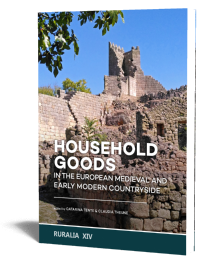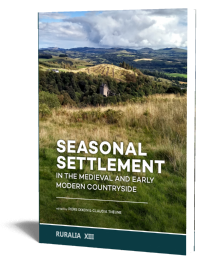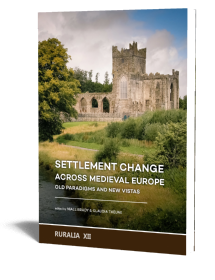Farmers’ trade and markets
Social and economic interaction in the medieval and early modern European countryside
Edited by Marie Ødegaard, Kjetil Loftsgarden & Claudia Theune | 2025
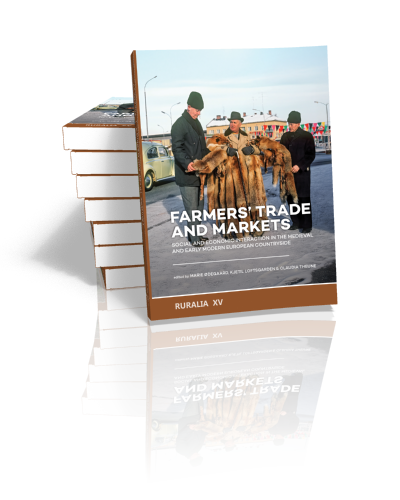
Farmers’ trade and markets
Social and economic interaction in the medieval and early modern European countryside
Edited by Marie Ødegaard, Kjetil Loftsgarden & Claudia Theune | 2025
Paperback ISBN: 9789464271324 | Hardback ISBN: 9789464271331 | Imprint: Sidestone Press Academics | Format: 210x280mm | 376 pp. | Ruralia XV | Series: Ruralia | Language: English | 20 illus. (bw) | 126 illus. (fc) | Keywords: medieval archaeology; rural archaeology; trade; market places; meeting places; production and consumption | download cover | DOI: 10.59641/rhw684kt | CC-license: CC BY-NC-ND 4.0
Read online 141 times
- Digital & Online access
-
Buy via Sidestone (EU & UK)
-
Buy via our Distributors (WORLD)
For non-EU or UK destinations you can buy our books via our international distributors. Although prices may vary this will ensure speedy delivery and reduction in shipping costs or import tax. But you can also order with us directly via the module above.
UK international distributor
USA international distributor
-
Bookinfo
Paperback ISBN: 9789464271324 | Hardback ISBN: 9789464271331 | Imprint: Sidestone Press Academics | Format: 210x280mm | 376 pp. | Ruralia XV | Series: Ruralia | Language: English | 20 illus. (bw) | 126 illus. (fc) | Keywords: medieval archaeology; rural archaeology; trade; market places; meeting places; production and consumption | download cover | DOI: 10.59641/rhw684kt | CC-license: CC BY-NC-ND 4.0
Read online 141 times
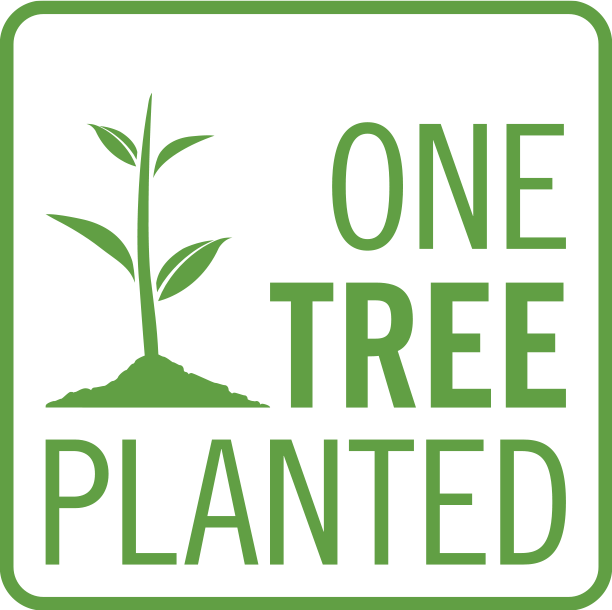
We will plant a tree for each order containing a paperback or hardback book via OneTreePlanted.org.
This volume brings together a series of case studies on the social and economic interaction and organisation in the medieval and early modern European countryside. In particular, it focuses on rural and smaller trade and markets that have remained relatively underexposed so far. It provides comprehensive presentations of new research on rural socio-economic interactions and networks, and how these are integrated into regional, trans-regional and even global exchange systems. The volume is characterised by an interdisciplinary scope and a broad geographical range, and provides new insights into the diversities and complexities of trade and rural landscape organisation.
The exchange of goods and services were integrated in cultural patterns and social strategies, which were part of the mechanisms of regionalisation and the formation of common cultures and identities. Markets and trading places were also important in terms of noneconomic aspects of society, with different types of social ties and networks, all essential components for dissemination of innovation and ideas. The volume investigates who benefitted, and who controlled the trade. The more or less unresolved question of how we can identify these smaller and informal trading places is a central topic of discussion in this volume.
Presented research suggests a considerably higher complexity in social and economic organisations and networks in rural areas than has previously been assumed. Both on local and regional as well as temporal scales. Local and regional differences in organisation and trade networks can highlight different modes of social organisation. Recognising how rural trade and markets were organised, and why, is fundamental for an understanding of the complexities of societies and regional variations in Europe as a whole.
Forword and introduction
Marie Ødegard – Kjetil Loftsgarden – Claudia Theune
Keynote
Meeting in the Dutch lowlands. The search for medieval and post-medieval open-air assembly sites in a northwest European context
Jan van Doesburg – Bert Groenewoudt
1 Overviews of rural markets in selected regions of Europe
Where are all the marketplaces? Southern Finland as an example of medieval and early modern rural trade in Finland
Tuuli Heinonen
Fairs and trade in the late medieval and early modern Danish countryside
Mette Svart Kristensen
Local rural markets in preindustrial Southern Germany
Rainer Schreg
Rural markets in medieval and early modern Hungary – a spatial-quantitative study
Laszlo Ferenczi
Medieval and Ottoman marketplaces in the Raška basin
Uglješa Vojvodić
2 Markets in small towns in central Europe
How much do we know about medieval rural markets in Silesia (Poland)?
Duma, Paweł
Market exchange and rural communities in the medieval Czech lands (ca. 900–1400)
Tomáš Klír – Ivo Štefan
Market places in small towns, the case study of Langenlois, Lower Austria
Claudia Theune – Ute Scholz
Lower Austrian market towns from a bird’s-eye view at around 1700
Ronald Kurt Salzer
3 Production and markets at the periphery of Europe – examples from Scotland and Northen Isles
From seasonal shore market to town: the emergence of Lerwick in Shetland (Scotland) in the 17th century
Mark Gardiner
Trade and markets in early modern orkney (Scotland)
Sarah Jane Gibbon – Jocelyn Rendall – Anne Mitchell – Jennifer Harland
Produce from the isles: the production and export of later medieval and early modern foodstuffs in Orkney and Shetland
Jennifer Harland– Bart Holterman – Ingrid Mainland – Julia Cussans
4 Approaches to the identification of markets and trade
The development and cultural significance of informal rural trade in the coastal and fjord districts of western Norway
Therese Nesset
Seascapes of connectivity. Magnates’ farms and trade in the Oslo fjord region
Christian Løchsen Rødsrud
Mountain markets in medieval Norway – rural trade and its socioeconomic significance
Kjetil Loftsgarden – Marie Ødegaard
Medieval quarrying and rural stone building trade in Hamar diocese, Norway
Kristian Reinfjord
The birth of business – risk management and social relations among farmers in Jämtland and traders in Trondheim 1800−1850
Sven Olofsson
Silver from Sala silver mine – controlled trade or shadow market?
Berg Nilsson, Lena
‘This little potter went to market’: The use of ceramic evidence to study the socioeconomic landscapes of rural markets in medieval Yorkshire (England)
Yannick Signer
Rural marketplaces and fairs in medieval Luxembourg – the examples of Enelter and the Helperknapp
Christiane Bis-Worch – Schoellen, André
Tyrolean garnet. From rural mining in the high mountains to the European gemstone markets
Bianca Zerobin – Roland Köchl
Novel notes: examples of commodity money and fiat money in the Viking Age of Eastern Europe
Monika Maleszka-Ritchie
The village markets of early medieval/Byzantine Cyprus and Greece
Athanasios K. Vionis
6 Transport and trade – connecting producers and markets
Following the herd. Oxen trade and breeding in the Netherlands as an example of rural-urban synergy in the late medieval and early modern periods
Jaap Evert Abrahamse – Rowin van Lanen
Livestock trails and cattle fairs in the north-west of the Iberian Peninsula in medieval and post-medieval times
Margarita Fernández-Mier– Pablo López-Gómez– Elías Carballido Gonzaléz
Forgotten trade, forgotten villages. A case study of medieval trade routes and settlement abandonment in Fejér county, Hungary
Máté Stibrányi – Csilla Zatykó
The rural area around Old Buda
Adrienn Papp
Dr. Marie Ødegaard
Marie Ødegaard is an associate professor at the Museum of Archaeology, University of Stavanger, with a focus on Iron Age and medieval archaeology. Research interests include settlement archaeology, assembly sites and state formation processes. She is currently project leader of Viking Beacons – militarism in northern Europe, granted by the Research Council Norway (2021-2025).
Dr. Kjetil Loftsgarden
Kjetil Loftsgarden is an associate professor at the Museum of Cultural History, University of Oslo. His main area of expertise is iron and iron production, trade, meeting- and marketplaces, as well as the societal consequences of climatic and environmental changes in Iron Age Scandinavia. He is currently leader of the project ‘Eidsborg rock – production and trade of whetstone in the Viking Age’ (2023-2027), funded by the Norwegian Research council.
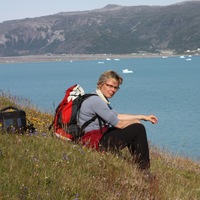
Prof. dr. Claudia Theune
Claudia Theune is Professor of Historical Archaeology at the University of Vienna with a focus on contemporary archaeology, on medieval and post-medieval marginal landscapes and on early medieval funeral and social archaeology.
Abstract:
This volume brings together a series of case studies on the social and economic interaction and organisation in the medieval and early modern European countryside. In particular, it focuses on rural and smaller trade and markets that have remained relatively underexposed so far. It provides comprehensive presentations of new research on rural socio-economic interactions and networks, and how these are integrated into regional, trans-regional and even global exchange systems. The volume is characterised by an interdisciplinary scope and a broad geographical range, and provides new insights into the diversities and complexities of trade and rural landscape organisation.
The exchange of goods and services were integrated in cultural patterns and social strategies, which were part of the mechanisms of regionalisation and the formation of common cultures and identities. Markets and trading places were also important in terms of noneconomic aspects of society, with different types of social ties and networks, all essential components for dissemination of innovation and ideas. The volume investigates who benefitted, and who controlled the trade. The more or less unresolved question of how we can identify these smaller and informal trading places is a central topic of discussion in this volume.
Presented research suggests a considerably higher complexity in social and economic organisations and networks in rural areas than has previously been assumed. Both on local and regional as well as temporal scales. Local and regional differences in organisation and trade networks can highlight different modes of social organisation. Recognising how rural trade and markets were organised, and why, is fundamental for an understanding of the complexities of societies and regional variations in Europe as a whole.
Contents
Forword and introduction
Marie Ødegard – Kjetil Loftsgarden – Claudia Theune
Keynote
Meeting in the Dutch lowlands. The search for medieval and post-medieval open-air assembly sites in a northwest European context
Jan van Doesburg – Bert Groenewoudt
1 Overviews of rural markets in selected regions of Europe
Where are all the marketplaces? Southern Finland as an example of medieval and early modern rural trade in Finland
Tuuli Heinonen
Fairs and trade in the late medieval and early modern Danish countryside
Mette Svart Kristensen
Local rural markets in preindustrial Southern Germany
Rainer Schreg
Rural markets in medieval and early modern Hungary – a spatial-quantitative study
Laszlo Ferenczi
Medieval and Ottoman marketplaces in the Raška basin
Uglješa Vojvodić
2 Markets in small towns in central Europe
How much do we know about medieval rural markets in Silesia (Poland)?
Duma, Paweł
Market exchange and rural communities in the medieval Czech lands (ca. 900–1400)
Tomáš Klír – Ivo Štefan
Market places in small towns, the case study of Langenlois, Lower Austria
Claudia Theune – Ute Scholz
Lower Austrian market towns from a bird’s-eye view at around 1700
Ronald Kurt Salzer
3 Production and markets at the periphery of Europe – examples from Scotland and Northen Isles
From seasonal shore market to town: the emergence of Lerwick in Shetland (Scotland) in the 17th century
Mark Gardiner
Trade and markets in early modern orkney (Scotland)
Sarah Jane Gibbon – Jocelyn Rendall – Anne Mitchell – Jennifer Harland
Produce from the isles: the production and export of later medieval and early modern foodstuffs in Orkney and Shetland
Jennifer Harland– Bart Holterman – Ingrid Mainland – Julia Cussans
4 Approaches to the identification of markets and trade
The development and cultural significance of informal rural trade in the coastal and fjord districts of western Norway
Therese Nesset
Seascapes of connectivity. Magnates’ farms and trade in the Oslo fjord region
Christian Løchsen Rødsrud
Mountain markets in medieval Norway – rural trade and its socioeconomic significance
Kjetil Loftsgarden – Marie Ødegaard
Medieval quarrying and rural stone building trade in Hamar diocese, Norway
Kristian Reinfjord
The birth of business – risk management and social relations among farmers in Jämtland and traders in Trondheim 1800−1850
Sven Olofsson
Silver from Sala silver mine – controlled trade or shadow market?
Berg Nilsson, Lena
‘This little potter went to market’: The use of ceramic evidence to study the socioeconomic landscapes of rural markets in medieval Yorkshire (England)
Yannick Signer
Rural marketplaces and fairs in medieval Luxembourg – the examples of Enelter and the Helperknapp
Christiane Bis-Worch – Schoellen, André
Tyrolean garnet. From rural mining in the high mountains to the European gemstone markets
Bianca Zerobin – Roland Köchl
Novel notes: examples of commodity money and fiat money in the Viking Age of Eastern Europe
Monika Maleszka-Ritchie
The village markets of early medieval/Byzantine Cyprus and Greece
Athanasios K. Vionis
6 Transport and trade – connecting producers and markets
Following the herd. Oxen trade and breeding in the Netherlands as an example of rural-urban synergy in the late medieval and early modern periods
Jaap Evert Abrahamse – Rowin van Lanen
Livestock trails and cattle fairs in the north-west of the Iberian Peninsula in medieval and post-medieval times
Margarita Fernández-Mier– Pablo López-Gómez– Elías Carballido Gonzaléz
Forgotten trade, forgotten villages. A case study of medieval trade routes and settlement abandonment in Fejér county, Hungary
Máté Stibrányi – Csilla Zatykó
The rural area around Old Buda
Adrienn Papp
Dr. Marie Ødegaard
Marie Ødegaard is an associate professor at the Museum of Archaeology, University of Stavanger, with a focus on Iron Age and medieval archaeology. Research interests include settlement archaeology, assembly sites and state formation processes. She is currently project leader of Viking Beacons – militarism in northern Europe, granted by the Research Council Norway (2021-2025).
Dr. Kjetil Loftsgarden
Kjetil Loftsgarden is an associate professor at the Museum of Cultural History, University of Oslo. His main area of expertise is iron and iron production, trade, meeting- and marketplaces, as well as the societal consequences of climatic and environmental changes in Iron Age Scandinavia. He is currently leader of the project ‘Eidsborg rock – production and trade of whetstone in the Viking Age’ (2023-2027), funded by the Norwegian Research council.

Prof. dr. Claudia Theune
Claudia Theune is Professor of Historical Archaeology at the University of Vienna with a focus on contemporary archaeology, on medieval and post-medieval marginal landscapes and on early medieval funeral and social archaeology.
- Digital & Online access
-
Buy via Sidestone (EU & UK)
-
Buy via our Distributors (WORLD)
For non-EU or UK destinations you can buy our books via our international distributors. Although prices may vary this will ensure speedy delivery and reduction in shipping costs or import tax. But you can also order with us directly via the module above.
UK international distributor
USA international distributor
- Browse all books by subject
-
Search all books

We will plant a tree for each order containing a paperback or hardback book via OneTreePlanted.org.
You might also like:
© 2025 Sidestone Press KvK nr. 28114891 Privacy policy Sidestone Newsletter Terms and Conditions (Dutch)
